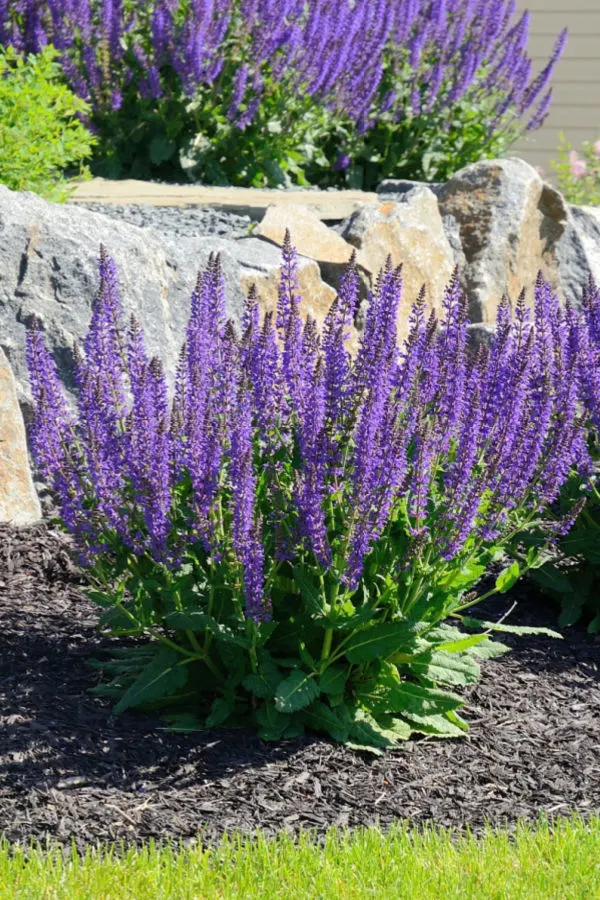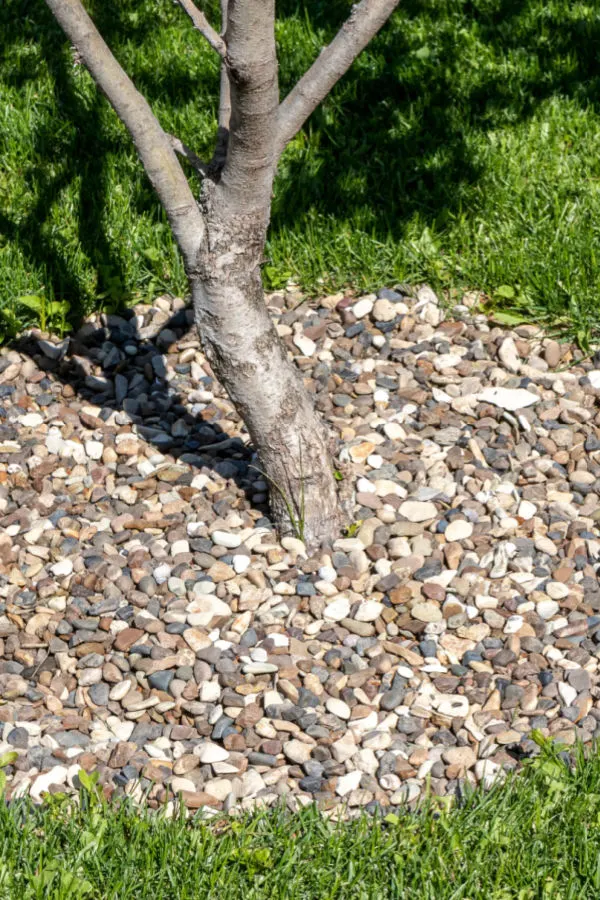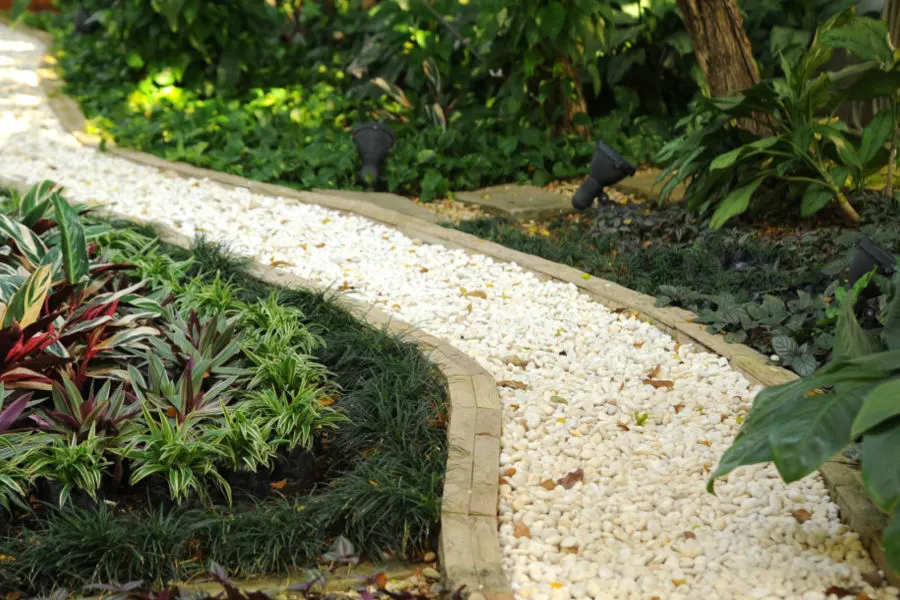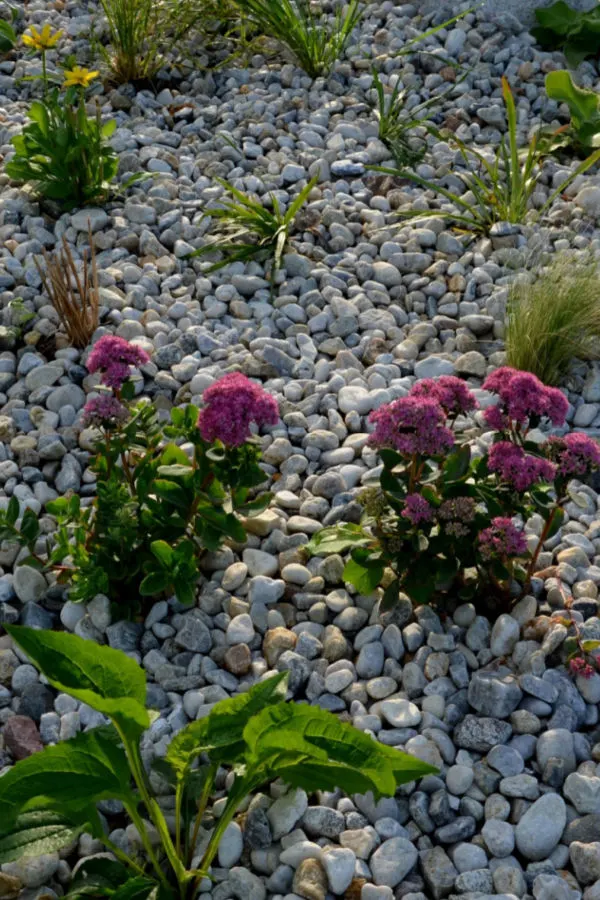When it comes to using stone as a mulch in the landscape successfully, it all comes down to knowing where stone will work well, and where using it may cause more problems than it solves.
Rock has become a popular choice in recent years for using as a mulch. It is certainly easy to see why when you think about all of the advantages. For starters, unlike organic mulches, stone doesn’t break down and disappear over time.
Shredded hardwood, bark, pine, cypress, straw and other organic-based mulches decompose as they age. Although this can be extremely helpful in building soil strength and vitality, it will need replacing on a regular basis. And as many know, that can cost a significant investment in both time and money to replace year after year!

On the other hand, rock mulch can last for decades in a bed space. Although rock will slightly erode from rain and snow over time, it can take 50 years or more to see any noticeable change in its size or make-up. Another words – as a mulch, it’s pretty much for life!
Advantages Of Using Stone As A Mulch
Beyond its longevity, rock mulch can have other advantages as well. Especially when it comes to insects and insect control. Unlike wood-based mulches, rock does not attract insects.
As wood and organic mulch products break down, they become both a food and habitat source for insects. Insects that can not only harm your plants and soil, but also nearby structures. That is exactly why using mulch right next to wood structures can be dangerous – simply because of the termites it can attract.
Rocks can also be an excellent choice for mulching hillsides and steep terrain. Traditional mulches don’t fair well in these situations. Rain can easily wash lightweight mulch down a slope, whereas heavier rock mulch can stay in place and hold the soil firm underneath as well.

Finally, rocks can be extremely easy to maintain. Not only are they long-lasting, they don’t require constant attention to keep them looking their best. Mulch often fades quickly giving beds a dull look, but stone never loses it’s appearance over time. It may take a bit of a spray with water now and then to remove grime, but all in all, it stays fresh.
How To Use Stone As A Mulch
With all of those advantages, you may be wondering why not just use rock to mulch everywhere? Unfortunately, stone mulch does have a few limitations. And knowing just where to use it, and where not to can make all the difference in having an easy care landscape with thriving plant life, or one where plants struggle to even survive.
With that in mind, here is a look at where stone mulch works best, and where it’s best to still use organic mulches for optimum results!
Where To Use Stone As A Mulch
So where does it make most sense to use a stone mulch vs. organic options? For starters, one of the best areas to use rock mulches are up against the foundation of any structure or building.

As mentioned prior, using stone here can keep insects (especially termites and carpenter ants) at bay. Using stone against foundations can also help with drainage as well. Stone will help to drain away excessive moisture – and keeping moisture away from foundations is never a bad idea.
Here is the best part of all, you don’t have to use stone for the entire bed space around structures. By simply using stone to mulch 12 to 18 inches out from the foundation, you can then plant shrubs, bushes, perennials and more in traditional mulch. When used in combination, stone and organic mulches can look fantastic together!
Around Trees & Shrubs
Stone makes an excellent mulch for using around trees and large shrubs. Not only will it allow moisture to drain through easily to tree roots, it also stays in place and is forever.
A lot of organic mulch is wasted every year to simply ring trees and large bushes. They simply do not need the mulch to break down as a soil additive to grow to their full potential, so using rock here makes perfect sense.
The same goes for flowerbeds and walkways that are planted with durable shrubs and small bushes. Rock is great for sidewalk flowerbeds because it stays in place. All too often, organic mulches blow and get kicked onto walkways, but stone eliminates this issue.

Speaking of walkways, stone is also an excellent choice for pathways and other non-planting areas. Using organic mulch in these spaces is simply a waste of natural resources. Stone looks great and is permanent. It also happens to be easy to maintain with organic sprays for weed control where nothing will ever grow. See : How To Use Vinegar To Kill Weeds
Where Not To Use Stone As A Mulch
So we have covered where stone works well – but what about where to avoid using it? One of the most common mistakes gardeners make in using stone mulch is putting it where they will be planting often.
Using stone to mulch flowerbeds where you plant annuals and smaller or more tender perennials is never a good idea. To begin with, it can be difficult pulling back rock and working in the soil on a regular basis. Not only can the soil be hard to move with rocks above, digging around rock often will turn many of the stones under the surface.
But even more, annuals and tender perennials need nutrients. Nutrients that organic mulches can give to the soil as they break down. Finally, rocks are wonderful for attracting in and holding heat. Unfortunately, that is not good for annuals and perennials that can easily dry out or even burn from the heat.
This is exactly why stone mulch should never be used in containers or baskets either. The heat the rock will hold in the middle of summer will burn plants quickly.

One final note on mulching annual and small perennial flowerbeds, you are far better off to fill your beds with plants than any mulch – whether its organic or stone. For traditional perennial flowerbeds, the best method to control weeds is to simply plant thick!
Fill Those Beds With Plants!
This allows beds to fill up creating a natural barrier against drifting weed seeds. Not only that, but the dense foliage looks great, and best of all, saves big on budget by not having to purchase mulch at all! See: The 4 Biggest Flowerbed Mulching Mistakes – How To Stop Weeds Forever!
Here is to successfully using stone as a mulch in your landscape! For more on using mulch in your flowerbeds and gardens, check out all of our mulching articles on the blog.
Follow Our Facebook Page For Great Gardening Tips And Advice! This Is My Garden Facebook Page
This Is My Garden is a garden website created by gardeners, for gardeners. Jim and Mary Competti have been writing gardening, DIY and recipe articles and books and speaking for over 15 years from their 46 acre Ohio farm. They publish three articles every week, 52 weeks a year. Sign up today to follow via email, or follow along!

